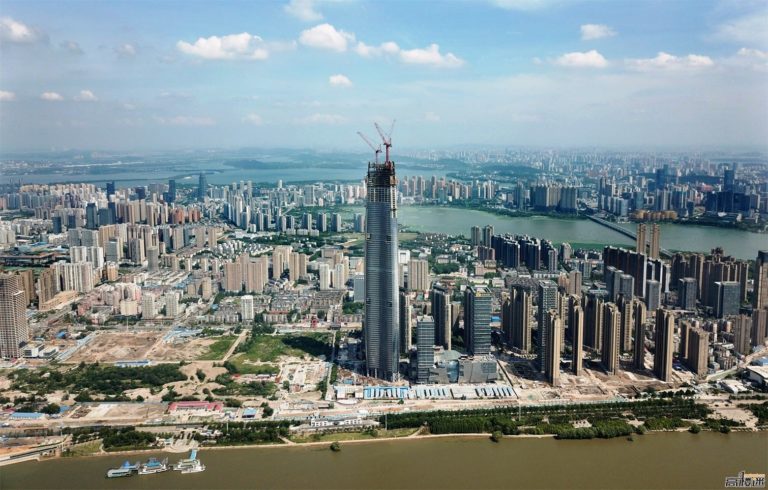Straddling the upper reaches of the Yangtze River, Chongqing is one of China’s largest and most important cities. In 2020, Chongqing’s economy ranked as the 6th largest in China. With a GDP worth nearly $700 million measured by purchasing power parity, Chongqing has the largest economy of any inland city in China, even more so than nearby Chengdu.
With an economy roughly the same size as that of Iraq or the UAE, Chongqing’s economy is an important driver of the economy of southwest China. After growing rapidly through the 2010’s, Chongqing’s economy was still growing at more than 6% in 2019. For an economy the size of Chongqing, this is a high rate of growth. For comparison, most large cities in rich countries have annual GDP growth rates of between 1% and 2%.
As a hub of commerce and finance in southwest China, Chongqing leads the region in certain areas: car manufacturing, infrastructure and finance. With inroads on many of China’s most important industries, Chongqing is a city whose economy if worth understanding better.
The Economy of Southwest China
Along with Shanghai, Tianjin and Beijing, Chongqing is one of only four directly administered cities in China. Chinese cities with this distinction enjoy a high level of support from the central government in Beijing. This means they receive benefits such as: increased autonomy in policy making decisions, tax breaks, tariff-free zones, increased economic stimulus, etc. all of which affect the economy of Chongqing
Among these four cities, Chongqing is unique in that it is the largest by land area and the most populous. Its population of 31 million year-round residents are spread out over many distinct districts, including the built up cluster surrounding Yuzhong Peninsula, smaller urban clusters such as Wanzhou and Hechuan, rural river towns that benefitted from the flooding of the Yangtze River and mountain hamlets near the southern part of the city’s borders. While these areas are all within Chongqing city limits, the word “Chongqing” makes most people in the region think of the built-up area surrounding Yuzhong Peninsula.
Because of the large area that encompasses Chongqing, the urban-rural population ratio is still quite low as compared to other Chinese areas. In 2017, the urban population made up 64% of Chongqing’s entire population, a dramatic increase from the 32% urban-rural ration in 1998.
This figure is still a ways off from richer coastal regions such as Shanghai (88%,) Beijing (86%,) Tianjin (83%,) Guangdong (70%) and Jiangsu (69%.)
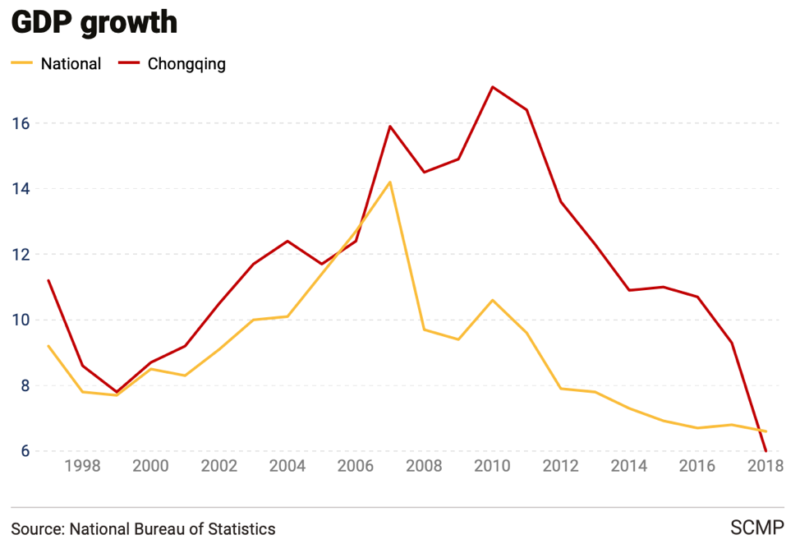
Along with more people moving to the city, during the past twenty years, Chongqing’s economy has grown rapidly. It’s per capita disposable income rise to 14,900 yuan in 2019, a 6.2% increase on last year. Chongqing’s GDP per capita has risen from 5,579 yuan in 1998 to a staggering 63,689 yuan in 2017. However, in recent years its growth rate has slowed substantially. Despite this, it is still growing and continues to attract business and investment alike. With such a large population and a relatively high proportion of residents still living in rural areas, Chongqing has enormous potential when it comes to business.
Not only unique for its demographic shifts, Chongqing’s distinct geography shapes its economic fortune as well. Called “the city built on hills” by locals, the development of Chongqing was historically constrained by the ring of mountains surrounding it. Due to its mountainous topography and the fact that it is located thousands of kilometers inland from the sea, Chongqing’s only means of trade in the past was the Yangtze River. Nowadays, the economy of Southwest China benefits immensely from being connected to maritime trade by the dredged and widened Yangtze River, which is navigable year-round and provides the region with a steady flow of goods.
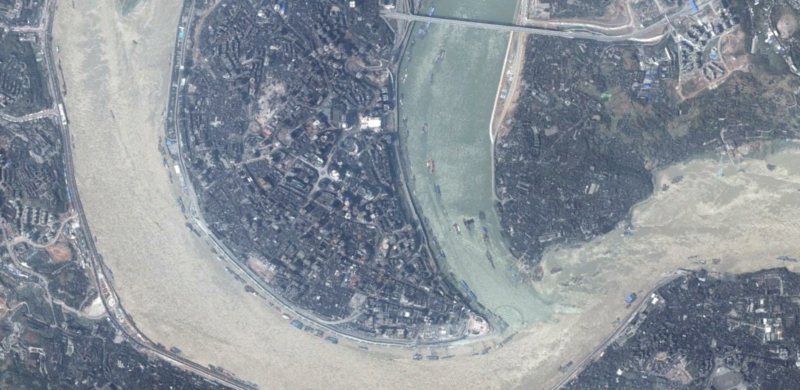
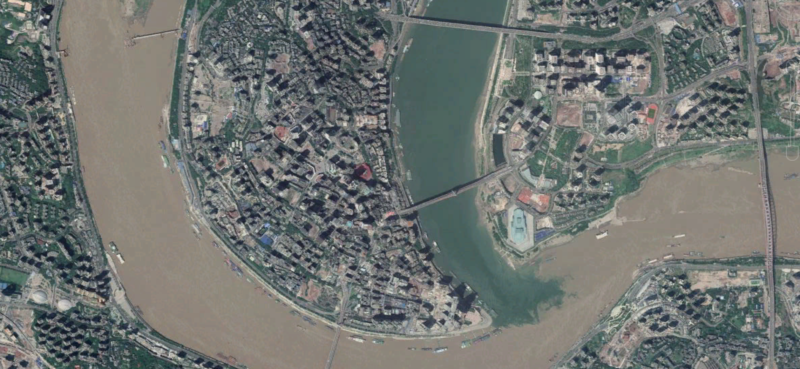
How Chongqing’s financial sector has become a beacon of hope for domestic and multinational corporations alike
After real estate scandals in 2008 and the subsequent dark years of Chongqing finance sector, many doubted that the city’s financial market could every recover. After mediation from the national government and a thorough shaking down, the city’s financial markets were cleaned of their scandals, but left in a dire situation. During Huang Qifan’s five years (2011-2016) as mayor of Chongqing however, the city’s financial sector has many an astounding recovery, ranking as the third city in China to set up a financial district, behind Beijing and Shanghai, and even in front of Shenzhen. Many say the city was only able to accomplish this because of Huang Qifan’s sweeping reforms.
Huan Qifan’s first order of business was to collaborate with the national government to develop a sector of the city specifically designated for finance. The sector, just north of the Jialing River across from the Yuzhong Peninsula, is aptly called Jiangbeizui, or the “Area North of the River.” Jiangbeizui CDB is the only national strategic financial center in Central and Western China. A spectator for the opening of Shanghai’s Pudong CDB, some speculate that the mayor was influenced by that city’s design while planning Jiangbeizui CDB, which, like Pudong CDB, is right across a river from the historic downtown center of Chongqing.
The area has grown substantially since opening in the early 2010s. From a cluster of ancient lanes and traditional courtyard homes in 2003 to a new financial sector in 2011 and finally to an internationally recognized financial district today, Jiangbeizui is a testament to Chongqing’s remarkable growth. In 2019, there were already 216 financial firms that had set up shop in Jiangbeizui, more than 60 of which had international operations.
Some may wonder what attracted all these Fortune 500 companies to open in Chongqing. Besides the city’s many other qualities, tax breaks and favorable policies lent a helping hand in attracting investment in the city, especially by financial firms. Among other policies, one that may help companies thinking of expanding into Chongqing’s finance sector awards licenses to small-scale financial firms. This policy extends licensing benefits to smaller financial firms. Through these reforms in Chongqing’s financial sector, the city has been able to outperform its peers.
Restructuring Chongqing’s Logistics Hub Capabilities to Increase Business and Profits
The simultaneous implementation of a new industrial policy and the opening of five specific districts in 2013 by the Chongqing government added to not only the economic growth of the city, but also to its logistics capabilities. A “localized and clustered layout” policy aims to cluster factories and offices into interconnected grouping that will drive down logistics costs, thereby luring more companies to do business in the city. Already, automotive companies in Chongqing have reported decreasing their logistics costs by 80%, twice. Increased efficiency of Chongqing’s logistics hub capabilities is a boost to Chongqing’s economy as it increased the desirability of doing business in the city.
Meanwhile, the “Five Function Districts,” as they are officially called, are separate districts designated around the city, but designed to work together to increase inefficiency and output while working within a logical geographical framework. The five functional areas are named the “urban function core area, urban function expansion area, new urban development area, northeastern Chongqing ecological conservation development area and southeastern Chongqing ecological protection development area.”
In addition to these policies, new trains connecting Chongqing directly to Europe have added to the increased efficiency and output of the city’s logistics capacity. Part of China’s Belt and Road Initiative, these trains will offer a transport alternative to maritime trade. In addition, they will increase the flow of goods between China and countries along the route. Combined with the “Five Function Districts” and the “localized and clustered layout” policy, Chongqing’s economy has benefitted from increased ease of transporting goods and ideas.
Chongqing Places Hope in Green Manufacturing to Revive its Slowing Industries
As a province-sized entity, Chongqing is China’s second-largest automotive manufacturer. Over the years, it has attracted household names in the automotive industry, such as Hyundai, General Motors and Ford. The company has also been the home of many nationally and internationally renowned manufacturers. These companies have set up shop in the city and have invested in Chongqing’s economy. Due to shifts in global supply chains and consumption patterns however, the growth of automotive and manufacturing industries in Chongqing has slowed.
Despite decreasing sales in the past couple of years, the city is betting on the transformation of the automotive and manufacturing industries. With companies and governments around the world putting more and more effort towards being environmentally friendly, it should be no surprise that Chongqing is working to do the same.
Slowing growth, demand from consumers and rising labor costs have pushed Chongqing to rethink how its manufacturing industry runs. The city has therefore begun implementing policies that favor green manufacturing and commending manufacturers who produce environmentally-friendly products in a push to increase Chongqing’s Green Manufacturing Industry.
In 2018 the city government released an official three-year plan to further implement green manufacturing in Chongqing. The report stresses the importance of shifting to green manufacturing by praising companies that have made exceptional progress on that front. It also emphasizes the criteria of attaining green manufacturing through five main tasks: construction environmentally-friendly factories, developing green campuses, creating environmentally-friendly products, building green supply chains and fostering environmentally-friendly service platforms.
In September 2019, a national report ranking companies on their efforts to manufacture green products found that 36 companies in Chongqing had made it on the list. Also earlier this month, a company from Chongqing was received praise on media outlets for manufacturing fully automated environmentally-friendly lights. Silian Opto, located in a suburban region of Chongqing, was able to profit immensely after manufacturing these high-tech lights when the local government of suburban Dazu decided to place a massive order of them. This praise serves to further encourage the development of green manufacturing in Chongqing.
The shift to green manufacturing in Chongqing is not an isolated event; it is happening worldwide. Foreign companies that are already in the green manufacturing industry or those that are considering taking steps to become more environmentally-friendly might look to Chongqing as an opportunity in this increasingly common field.
Chongqing’s IT Industry Continues to Attract Electronics and Telecommunications Companies
At the end of August 2019, Chongqing held the China International IT Expo, which attracted mainly household names in the IT sector. In addition, the expo further solidified the city’s growing status as a Chinese IT hub.
Then in the beginning of September, Chongqing secured a deal with Singapore to develop telecommunication connectivity and further develop trade links. It also scored a deal with Baidu to develop artificial intelligence in the city. Then it scored on another deal with Huawei to develop AI and 5G kit. Clearly, the city’s government is keen on developing Chongqing’s IT Industry.
Whether IT companies are attracted to Chongqing’s growing middle-class market or its generous tax policies, one thing is clear: more and more of them are interested in setting up shop in the city, thus adding fuel to the growth of Chongqing’s economy.
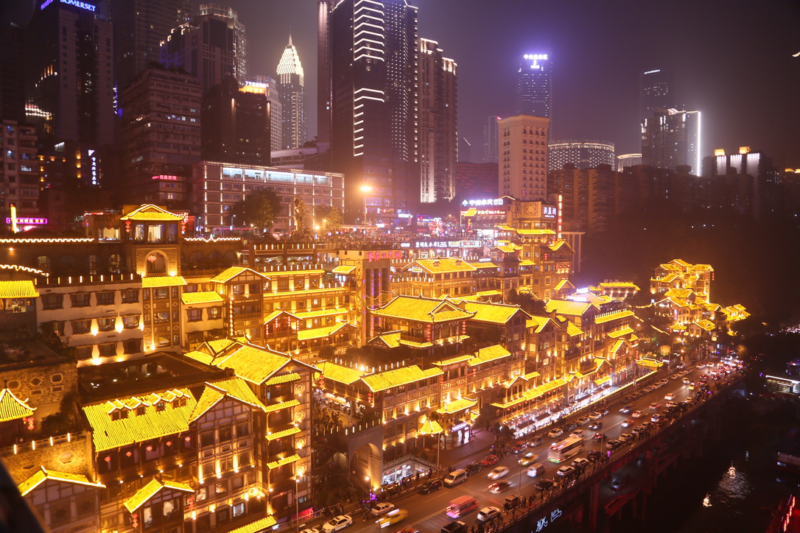
Online Media Celebrities and Red Tourism Fuel a wave of Tourism in Chongqing
During the National Holiday Week, a nation-wide holiday at the beginning of October every year, millions of Chinese vacationers head to the airport or train station for a week of travel. While the share of Chinese travelers who head abroad during this period has increased over the years, the number of overall travelers has also increased. This has led to a dramatic increase in domestic travel in China during the National Holidayweek, which has directly benefitted Chongqing’s tourism industry.
During the 2019 Mid-Autumn Festival, a three-day holiday weekend in mid-September, the city welcomed over 11 million tourists, a 11% increase on last year’s tourist numbers. This year tourists reportedly spent 6.9 billion yuan in city, which was a juicy 69% increase on last year’s numbers. With the National Day Week just around the corner, Chongqing’s tourism industry is awaiting the arrival of millions more tourists.
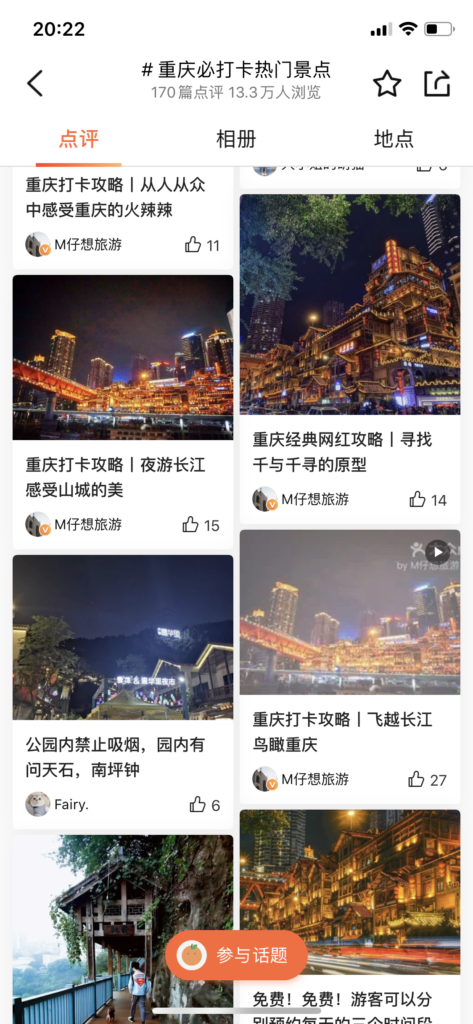


While increasing salaries and transportation improvements have indeed caused this surge in tourism in Chongqing, another unlikely source of this newfound attention is mobile apps such as Tiktok and Dazhong Dianping, an online review platform. In recent years, the advent of TikTok’s short and shareable videos have fueled notoriety for the city’s most breathtaking landmarks, including Hongya Caves, Ciqikou, South Mountain and Wulong (where Avenger’s was filmed.)
Filming short videos of yourself in front of one of these landmarks and posting it on Tiktok or Wechat has been given the name daka, which roughly translates into “snap a pic.” Originally started by Chinese celebrities, the media trend has influenced young and old travelers alike to pose in a variety of ways to impress their friends on social media. Some of the poses include making a hard shape silhouette your hands and the night lights of Hongya Caves, standing in front of the Chongqing metro with your mouth open so as to appear to be eating the oncoming train, etc.
An emerging trend in daka is the spread of penthouse pools and “floating hotels” offering sweeping urban vistas. In a vertical city such as Chongqing, there will be no problem attracting this sort of selfie-snapper. The city center and many other districts are already concrete jungles with many new skyscrapers and luxury high-rises under construction.
What’s more, September 2019 saw the opening of Raffles City Chongqing, part of the Chaotianmen Development project, an enormous vertical shopping mall and hotel dubbed the “Marina Bay Sands of Chongqing.” Located at the tip of the Yuzhong Peninsula and rising 73 stories above the confluence of the Jialing and Yangtze Rivers, the complex offers one of the most sought-after views in the city. The next phase of Chaotianmen will see the opening of a horizontal building connecting the upper floors of two building in the complex. With its perfect location atop Chongqing and luxurious amenities, this prime development is an opportunity for businesses to take further advantage of the daka craze that is fueling Chongqing’s tourist industry.



Besides daka, Chongqing has another factor lures in another demographic of travelers, which is those interested in Red Tourism. Growing rapidly in importance over the past few years, Red Tourism is any type of tourism related to history of the People’s Republic of China, most likely in the form of wartime memorials and museums. This increasingly important form of tourism has not forgotten Chongqing. In fact, the Chongqing’s tourism industry is increasingly benefitting from red tourists who are coming to visit the city’s twenty red tourist attractions, including Nie Rongzhen’s Memorial Hall, Gele Mountain Martyr’s Cemetery, Chongqing Hongyan Revolutionary Memorial Hall, etc.
All told, the throngs of tourists showing up at Chongqing’s airport and train stations is an opportunity for the city and businesses alike. With the increasing amount of tourists and consumption by tourists, Chongqing’s tourism industry has prospered, adding to the overall growth of Chongqing’s economy.
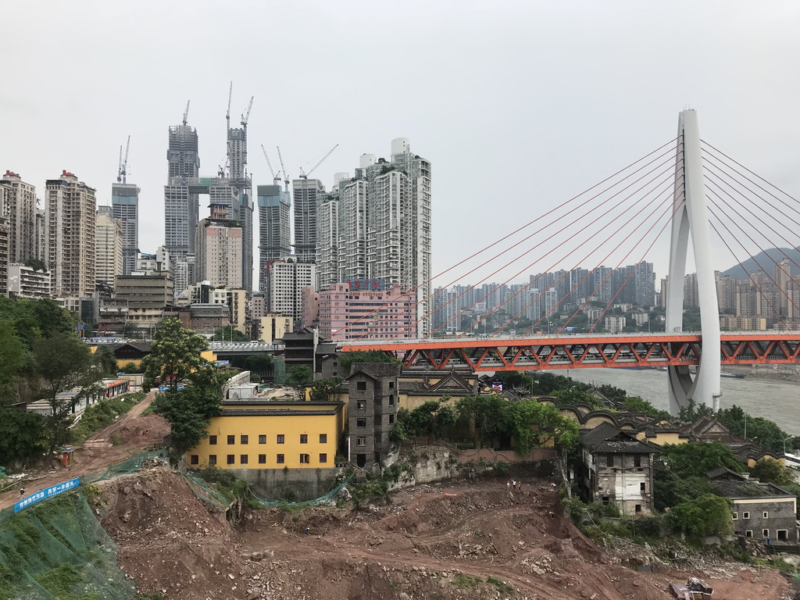
The Breakneck Speed of Infrastructure Development in Chongqing Attracts Business
With the world’s longest network of high-speed rails, China has made astounding accomplishments in high-speed rail technology and expansion over the last twelve years. With China’s first high-speed rail opening only in 2007, the network has grown remarkably since, now covering most of China’s large cities. It should come as no surprise then that infrastructure development in Chongqing has grown rapidly over the last twelve years as well.
Connections between Chongqing and other large cities in southwest China, such as Chengdu, Guiyang, Xi’an and Lanzhou have opened in recent years, bringing the city within a few hours’ train ride of their markets. Before the opening of high-speed rail, the train from Chongqing to Xi’an took eleven hours. It now takes four. Similar reductions have been made with other cities, including Chengdu, which is now only an hour and a half away. Because of the high-speed rail, it is now possible to super commute between these two cities.
In addition to the recently completed lines, the central government has published plans to link Chongqing to other regional cities, including Kunming and Wuhan. These new high-speed rail lines will not only connect provincial capitals, but they will also link Chongqing to markets in second- and third-tier cities, including Luzhou, Yibin, Yichang and Zhaotong.
In addition to improved connectivity between Chongqing and other cities, infrastructure development in Chongqing’s urban area has improved over the last fourteen years with continued expansions of the Chongqing Rail Transit. After opening line one in 2005, the network has grown rapidly to include ten lines today. In January of 2019, half of the Circle Line opened, linking nearly all of the other nine metro lines. Next year, the city is expected to open the other half of the Circle Line as well as one new line.
The increased expansion of high-speed rail, metro and highways in and around Chongqing is a boon to investment, business and the growth of the city’s economy. Through the increased connectivity that this type of infrastructure development brings, companies in the region can enjoy improved services, quicker deliveries, reliability transportation and a larger customer base.
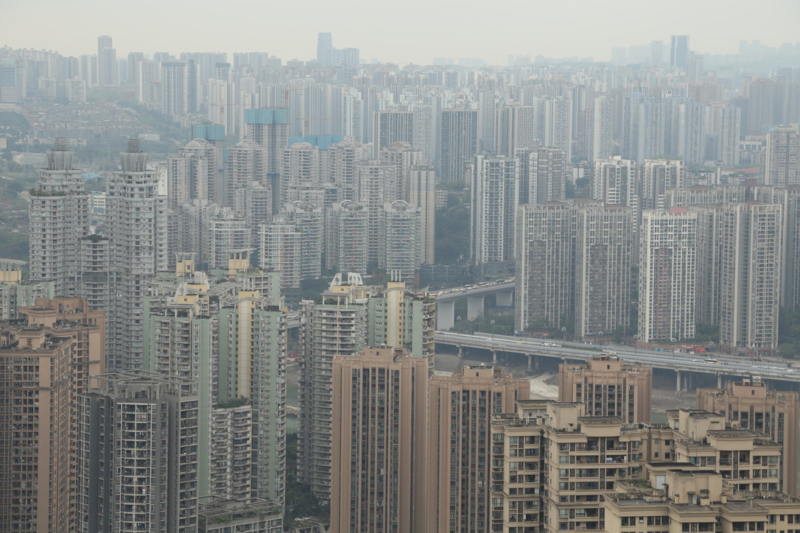
What is necessary for foreign companies to know about Chongqing’s Economy?
Chongqing’s former mayor Huang Qifan once told reporters that “all types of financial licenses are extremely valuable; they must be cherished.” The ambitious mayor set the tone for the growth of Chongqing’s economy over the past eight years by expressing his respect for financial reform. Foreign companies hoping to expand into Chongqing can first and foremost be comforted with news that the city government is keen to have them. Chongqing has shown China and the world that it is interested in attracting business and investment through its tax breaks, logistics hub reorganization and its business-friendly atmosphere.
While the city government is indeed keen to have new companies locate to Chongqing, it is also important for foreign companies to understand what direction Chongqing’s economy is heading.
Recent trends place green manufacturing higher in importance than Chongqing’s automotive industry, historically one of the pillars of Chongqing’s economy. The same can be said for the real estate industry in relationship to infrastructure investment in Chongqing. The sustained growth of Chongqing’s financial industry and the seemingly sudden expansion of its IT industry are also of utmost importance. Understanding these trends will help companies make valuable decisions.
Lastly, foreign companies should pay attention to demographic changes across China when considering how best to start operations in Chongqing. First, with a rural population still higher than that of the rest of China, Chongqing still has hidden economic potential living in its hinterland. Chongqing is far from being completely urbanized; its continued urbanization will be a boon to business. Second, with a rising middle class living in close proximity to Chongqing’s expanding transportation network, the possibility of economic growth is greatly increased. The more connections created by metro and high-speed rail stations in Chongqing, the more efficient it will be to do business in the city. As the city completes new infrastructure projects every year, businesses will have less difficulty moving around their products, people and ideas. Finally, internet trends influencing Chinese youth will provide possibilities for foreign companies. Understanding social media fads and internet sensations will help these companies win over young consumers.
Let China Paradigm have a positive economic impact on your business!
Listen to China Paradigm on iTunes





